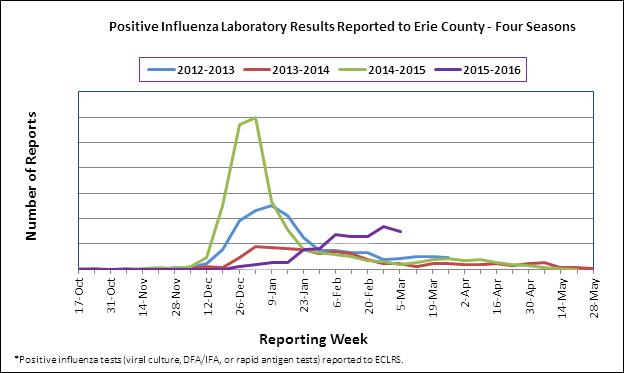Modified: May 17, 2016 3:57pm
Latest News

MEDIA RELEASE
From the Office of the Commissioner of Health, Dr. Gale R. Burstein
Date March 14, 2016
CONTACT: Mary C. St. Mary/Mary.StMary@Erie.Gov
Phone: 716.858.4941/ Mobile: 716.253.3925
Late Season Surge of Influenza Hits Erie County
Surveillance Data Shows Number of New Cases Rising Significantly
ERIE COUNTY, NY— Influenza has finally hit Erie County, as well as the rest of New York State. While last flu season peaked between the end of December and the beginning of January, this season’s flu activity has steadily increased since mid-January.
The number of positive tests for influenza (flu) has been increasing each week since the middle of January says Dr. Gale Burstein, Erie County Commissioner of Health (“ECDOH”). “Our surveillance data show that flu activity is currently widespread locally, and may continue to spread before we see the traditional flu season draw to a close. We could also experience another late season peak with Influenza B, as we have in years past.”
ECDOH urges Erie County residents to contact their health care provider if they think they have the flu. For those who do not have a primary care provider and need medical evaluation, seek care at an urgent care center. Most people with the flu will have a mild illness and will not require medical care or treatment with antiviral drugs.
Individuals having difficulty breathing, shortness of breath, or are dizzy and weak from possible dehydration, should seek medical evaluation immediately. If you are in a high risk group (pregnant females, have recently given birth or are breast feeding; people 65 years and older; people who are immunosuppressed where their body’s ability to fight off infection may be impaired; people with other chronic health conditions, such as asthma or other chronic lung disease, heart disease, diabetes, etc., people who live with or care for others who are at high risk of developing serious complications; and young children, especially those under 2 years of age) and develop flu symptoms, contact your health care provider. Remind them about your high risk status for flu.
The Centers for Disease Control and Prevention (CDC) recommends initiation of antiviral treatment as early as possible (within 48 hours of symptom onset), for those at high risk for complications. Antiviral therapies may reduce the severity of illness, decrease the risk of complications (including hospitalization) and shorten the duration of illness. “Contact your primary care physician or an urgent care center if you are concerned about your symptoms” said Dr. Burstein. “Emergency Departments should be utilized for emergencies. Typically, flu can be treated at home.”
If you have the flu, stay at home and rest. Wash your hands thoroughly and frequently. Avoid close contact with well people in your house so you do not make them sick. Drink plenty of liquids to prevent fluid loss (i.e., dehydration) and treat fever and other symptoms with over-the-counter medication.
It is NOT too late to receive a flu vaccine, especially since this year’s vaccine has been relatively effective against the most common strains of influenza in circulation. It is especially important for certain populations at high risk for serious flu complications, as noted above, to get vaccinated. People at high risk of developing serious complications, such as pneumonia, with flu, include individuals with certain medical conditions such as asthma, diabetes, morbid obesity, and chronic lung disease.
# # #
For More Information:
Erie County Department of Health
New York State Department of Health Influenza Surveillance Report
Centers for Disease Control and Prevention

